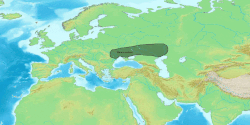
Back Persiese mitologie Afrikaans أساطير فارسية Arabic Fars mifologiyası Azerbaijani Mitologia persa Catalan Mitolohiyang Persyano CEB Perská mytologie Czech Iranische Mythologie German Περσική μυθολογία Greek Persa mitologio Esperanto Mitología persa Spanish
This article has multiple issues. Please help improve it or discuss these issues on the talk page. (Learn how and when to remove these messages)
|
| Part of a series on the |
| Culture of Iran |
|---|
 |
|
|
| Part of a series on |
| Indo-European topics |
|---|
 |
|
|
| Mythology |
|---|
Iranian mythology, or Persian mythology in western term (Persian: اسطورهشناسی ایرانی), is the body of the myths originally told by ancient Persians and other Iranian peoples and a genre of ancient Persian folklore. These stories concern the origin and nature of the world, the lives and activities of deities, heroes, and mythological creatures, and the origins and significance of the ancient Persians' own cult and ritual practices. Modern scholars study the myths to shed light on the religious and political institutions of not only Iran but of the Persosphere, which includes regions of West Asia, Central Asia, South Asia, and Transcaucasia where the culture of Iran has had significant influence. Historically, these were regions long ruled by dynasties of various Iranian empires,[note 1][1][2][3] that incorporated considerable aspects of Persian culture through extensive contact with them,[note 2] or where sufficient Iranian peoples settled to still maintain communities who patronize their respective cultures.[note 3] It roughly corresponds to the Iranian Plateau and its bordering plains.[4][5]
The Encyclopædia Iranica project uses the term Iranian cultural continent for this region.[6][7]
Cite error: There are <ref group=note> tags on this page, but the references will not show without a {{reflist|group=note}} template (see the help page).
- ^ Marcinkowski, Christoph (2010). Shi'ite Identities: Community and Culture in Changing Social Contexts. LIT Verlag Münster. p. 83. ISBN 978-3-643-80049-7.
- ^ "Interview with Richard N. Frye (CNN)". Archived from the original on 2016-04-23.
- ^ Frye, Richard Nelson (1962). "Reitzenstein and Qumrân Revisited by an Iranian". The Harvard Theological Review. 55 (4): 261–268. doi:10.1017/S0017816000007926. JSTOR 1508723. S2CID 162213219.
- ^ "IRAN i. LANDS OF IRAN". Encyclopædia Iranica.
- ^ Dialect, Culture, and Society in Eastern Arabia: Glossary. Clive Holes. 2001. Page XXX. ISBN 978-90-04-10763-2
- ^ "Columbia College Today". columbia.edu. Archived from the original on 2015-11-27. Retrieved 9 December 2015.
- ^ Sarkhosh-Curtis, V., Persian Myths (1993) London, ISBN 0-7141-2082-0
© MMXXIII Rich X Search. We shall prevail. All rights reserved. Rich X Search